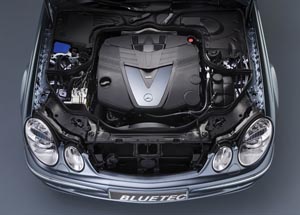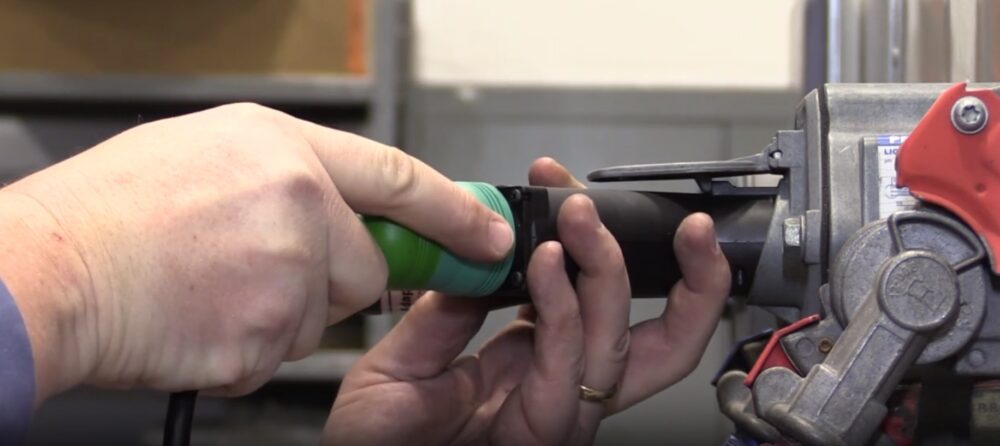By Larry Carley
Technical Editor
 Diesel engines are a popular alternative to gasoline engines because of their good fuel economy and torque. More than 55% of heavy-duty pickup trucks are now powered by diesel engines, as are 85% of Class 5 to 7 medium-duty trucks. The GM Duramax, Ford Powerstroke and Dodge Cummins Turbo Diesel engines represent the bulk of the service opportunities. As for passenger cars, diesels are only available in a few models (though this will change in the years ahead as auto makers plan to introduce new high-tech common rail, low emission diesel engines). Jeep has a 2.8L diesel option in its Liberty SUV, and VW offers turbo diesel fours in the Toureg, Passat and Golf. Mercedes also has a diesel-powered E320.
Diesel engines are a popular alternative to gasoline engines because of their good fuel economy and torque. More than 55% of heavy-duty pickup trucks are now powered by diesel engines, as are 85% of Class 5 to 7 medium-duty trucks. The GM Duramax, Ford Powerstroke and Dodge Cummins Turbo Diesel engines represent the bulk of the service opportunities. As for passenger cars, diesels are only available in a few models (though this will change in the years ahead as auto makers plan to introduce new high-tech common rail, low emission diesel engines). Jeep has a 2.8L diesel option in its Liberty SUV, and VW offers turbo diesel fours in the Toureg, Passat and Golf. Mercedes also has a diesel-powered E320.
 The main difference with working on diesels versus gasoline engines is that diesels have no ignition system. There are no spark plugs or ignition coils, but they do have glow plug start-up systems to help the fuel ignite when a cold engine is first cranked. Diesels also use a high-pressure direct injection fuel system, and have no throttle.
The main difference with working on diesels versus gasoline engines is that diesels have no ignition system. There are no spark plugs or ignition coils, but they do have glow plug start-up systems to help the fuel ignite when a cold engine is first cranked. Diesels also use a high-pressure direct injection fuel system, and have no throttle.
Engine speed is controlled by fuel delivery rather than throttle opening. The latest generation of diesel engines also uses “common rail” ultra-high pressure injection systems that operate at pressures up to 24,000 psi. The injectors are electronically controlled and deliver multiple injections to maximize power and minimize emissions, smoke and noise. So, like gasoline engines, today’s diesels have computer engine control systems.
You Need a Scan Tool
Diagnosing diesel performance and driveability problems is pretty much like that on a gasoline engine. You need a scan tool to access the onboard diagnostics and data stream information. The scan tool will display any diagnostic trouble codes that may be present so you can proceed with your diagnosis. By looking at the engine performance information data (PID) on the scan tool, you scan see if fuel pressure, injector pulse widths, boost pressure, fuel temperature, engine coolant temperature, manifold pressure, etc. are within specifications. Factory scan tools are expensive, but include the most features. Aftermarket scan tools may require special software for diesel applications, and may not include all of the self-tests and PIDs that are available in the factory scan tool.
Performance Programmer Tools
Some of the hottest new products for diesels today are performance programmer tools that allow you to overwrite the stock programming in the engine computer to increase horsepower, engine rpm, vehicle speed, transmission shift points and so on for performance, towing or fuel economy. Many of these tools come with various “power settings” that allow you to modify fuel injection timing and pulse width, increase boost pressure, and override the vehicle speed limiter. They also have a “save” feature that allows the vehicle computer to be reset back to the stock calibration. Some also provide basic scan tool functions and display fault codes and PIDs.
Most of these tools, though, are designed for a specific vehicle (GM Duramax, Ford Powerstroke or Dodge Cummins). Also, the tools only allow modifications to be made to one vehicle at a time, and are really designed more for the vehicle owner than service technicians. The tools are also expensive, typically costing $500 to $650 or more. Even so, they open the door to do custom tuning that you can’t do with an ordinary scan tool.
Programmer tool suppliers include Bully Dog, Hypertech, Quadzilla, Predator, Xcelerator/PPE and Smarty/MADs.
Troubleshooting with Temperature
Another handy tool to have when working on diesels is a handheld infrared pyrometer (thermometer). The pyrometer displays a digital temperature reading when it is aimed at a hot surface. Many models have a laser pointer that helps you see exactly where you are aiming the tool. Prices range from as low as $50 up to several hundred dollars depending on the features and temperature range of the tool.
An infrared pyrometer can be used to quickly find a dead cylinder on a diesel by checking the temperature of the exhaust at each cylinder port on the exhaust manifold. The exhaust coming from a dead cylinder will be much cooler than a good cylinder. Using this technique is often the fastest way to isolate a misfiring cylinder. Fuel and compression checks can then be made to determine if the problem is due to a blown head gasket, burned exhaust valve or bad fuel injector.
The same tool can also be used to troubleshoot engine cooling problems by checking the temperature of the coolant as it flows through the radiator hoses and radiator. A low reading at the thermostat outlet on a hot engine would tell you the thermostat is probably stuck shut.
Compression Gauge
To check compression on diesel engines, you will need a high pressure diesel compression gauge with an assortment of adapters to fit different diesel engines. Unfortunately, there’s no convenient spark plug hole on diesel engines to check compression, so you have to remove a glow plug or fuel injector. Also, diesel engines produce much higher cranking compression readings than gasoline engines (typically 350 to 400 psi or higher).
Fuel Injector Tools
Pulling injectors on a diesel engine usually requires special tools, too. For this task, you will need a slide hammer and various adapters designed to fit specific injectors and engines. For example, if you’re working on Cummins “B” and “C” Series 3.9L, 5.9L and 8.3L engines in Dodge trucks, you may need an 8 mm adapter to pull the injectors on a 1998-1/2 engine, a 12 mm adapter for injectors prior to 1994, and a 14 mm adapter for 1994 to 1998 engines. Injector tools and adapters are typically sold in sets designed to fit a series of engines.
Injection Pump Tools
Mechanical injection pumps also require some special tools for injection timing adjustments. A curved wrench may be needed to loosen the injection pump lock nut. On Cummins B Series 5.9L engines, a special 10 mm wrench with a 90° angle makes removing or installing the pump mounting bolts much easier.
Most Bosch injection pumps require a special splined 32-tooth socket to remove the delivery valve.
On older VWs with non-TDI diesel engines, an injector pump timing tool and gauge is required for Bosch VE injection pumps. A special tool is also required to remove the three-sided bolt on the side of Bosch VE injector pumps.
Timing gauge sets are also available for other diesels too, such as Cummins. The sets typically include mounting hardware and a dial indicator to set injector plunger travel. Cost for a Cummins gauge set is around $280.
Internal Engine Repairs
Some diesel engines have “wet” sleeve engine blocks. This saves money when the block needs to be overhauled because the old worn cylinder sleeves can be replaced with new ones. But to pull out the old sleeves, you will need some type of sleeve puller. The best ones have a hydraulic hand pump that makes the job much easier, but adds to the price. A hydraulic sleeve puller can cost as much as $1,600.
Service Tool Kits
One of the best ways to buy tools for diesel engine work is to buy a service tool kit for specific series of engines. Such a kit may include a compression gauge, adapter, injector puller and fuel line tools.


